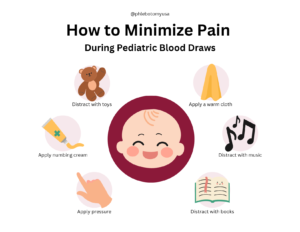02 Oct A Painless Approach to Pediatric Phlebotomy
Phlebotomy, which is when a nurse or doctor takes some of your blood, can be scary for kids. They see needles, are in a strange place, and worry about pain. As healthcare workers, we need to understand this and do our best to make it less painful for our youngest patients.
Why It’s Important to Reduce Pain
Babies and young kids, especially those who can’t understand things like grown-ups, might feel pain in a unique way compared to adults. Pain doesn’t just affect their bodies; it can also affect their minds. Sometimes, when they go through painful medical experiences, it can affect them even after it’s all done.
How Pain Affects Infants and Children
Medical procedures are tricky for kids because they don’t know how to deal with pain. This makes them feel scared, and might remember it for a long time. Take getting blood drawn as an example; it hurts a lot, and kids don’t understand why they have to go through that, which makes them even more upset. Plus, being in a strange place, seeing unfamiliar people, and knowing they’ll feel pain all make kids even more anxious. So, getting blood drawn can be really scary for them.
Effects on the Brain
When kids undergo painful medical procedures like blood draws, it can significantly impact their minds. They might start feeling really anxious, scared, or even develop something called PTSD. That’s why finding ways to make these procedures hurt less is super important. Kids who go through painful medical stuff can end up being scared of doctors and hospitals for a long time. But the good news is that healthcare providers can help by using special techniques. This can make kids feel better about going to the doctor and reduce the chances of them having long-lasting psychological effects.
How to Minimize Pain for Kids
Many methods are available to make blood draws less painful for kids. These techniques focus on providing pain relief while ensuring safety and efficiency. The child’s comfort and well-being are the top priorities in pediatric phlebotomy. Healthcare professionals use a variety of strategies to reduce pain and anxiety during the procedure, making it a positive experience for both the child and their parents.
Pain Relieving Creams
One standard method is using numbing creams or sprays before a blood draw. These are carefully applied to the skin around the spot where the needle will go in. They numb the skin, reducing how much it hurts when the needle is inserted. This technique is beneficial for kids who might feel pain more intensely.
Distraction Methods
Besides using numbing creams, distraction techniques help kids focus on something other than the procedure. They might chat with the child, tell stories, or give them toys or videos to watch. These distractions make the child less anxious and give them a feeling of control.
Comfort Measures
Making kids comfortable is critical to reducing pain during blood draws. Phlebotomists can use comforting measures like putting a warm cloth on the spot where the needle will go. This relaxes the muscles and improves blood flow, making the procedure less uncomfortable. They can also apply gentle pressure before and during the needle insertion, which makes the child feel more secure and reduces discomfort.
Healthcare professionals are skilled at using these comfort measures and customize them based on each child’s needs. These measures create a supportive and pain-reducing environment, ensuring a successful blood draw for the child.
How Phlebotomists Help
Healthcare professionals are essential in reducing pain during pediatric blood draws. Their expertise, abilities, and communication skills significantly impact the child and their family’s experience.
Training and Education for Phlebotomists Working With Kids
Phlebotomists need special training to work well with kids. This training helps them learn how to make procedures less painful and how to talk to kids effectively. They also study child development to understand how kids think and feel, allowing them to adjust their approach based on the child’s age and personality.
Communicating to Reduce Patient Anxiety
In phlebotomist training, they learn how to talk to kids and their parents in a way that makes everyone feel comfortable and safe. They use simple words to explain things and show pictures to help kids understand what’s happening. They also use tricks like blowing bubbles or playing calming music to help kids relax during the procedure. Plus, they let kids and parents make choices when they can, which makes kids feel more in control and less scared. This kind of communication is super important to make blood draws easier for kids.
In summary, healthcare professionals are critical in making blood draws less painful for kids. Special training gives them the necessary knowledge, skills, and communication strategies. Using effective pain management techniques and communicating openly and honestly can reduce anxiety, empower the child, and ensure a successful blood draw.
How Effective are Pain Reduction Methods?
It’s essential to check if the strategies we use to reduce pain during blood draws for kids are working well. This helps us keep improving the care we provide to patients.
Measuring Pain Levels in Kids
To accurately measure how much pain infants and children feel, we should use pain assessment tools specifically designed and proven to work for their age group. These tools consider things like the child’s physical reactions, how they behave, and what they can tell us about their pain. It’s important because different age groups may express pain differently, and these tools help us understand and address their pain accurately.
Learning More and Improving Techniques
Getting feedback from patients and their families is really helpful. It tells us if the ways we use to reduce pain are working well or if there are things we can do better. This feedback helps us ensure we’re doing our best to reduce pain during blood draws for kids.
The Future of Pediatric Phlebotomy
As technology gets better, we might find new and creative ways to make blood draws less painful for kids.
Advances in Technology and Their Impact
We can use new methods like needle-free devices or smaller needles to make blood draws hurt less. Additionally, as technology like virtual reality and augmented reality gets better, we can create fun and immersive experiences for kids during the procedure to keep their minds off any discomfort.
The Importance of Continued Research and Development
It’s really important to keep studying and finding better ways to reduce pain for kids during blood draws. By keeping up with new information and best practices, healthcare professionals can make sure that making the procedure less painful for kids is always a top priority.


